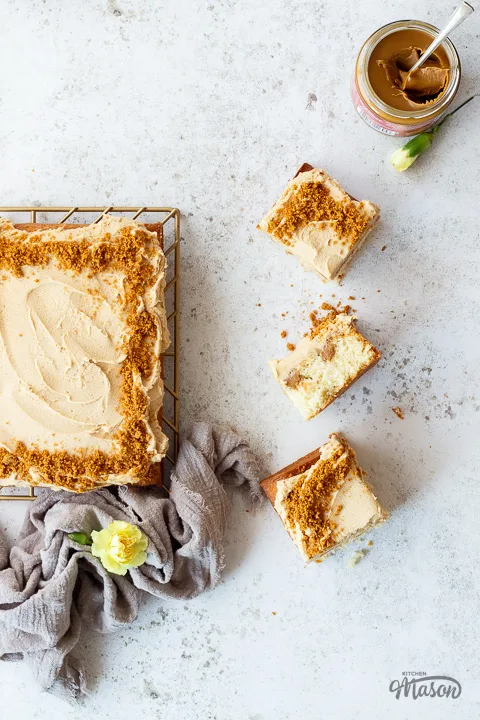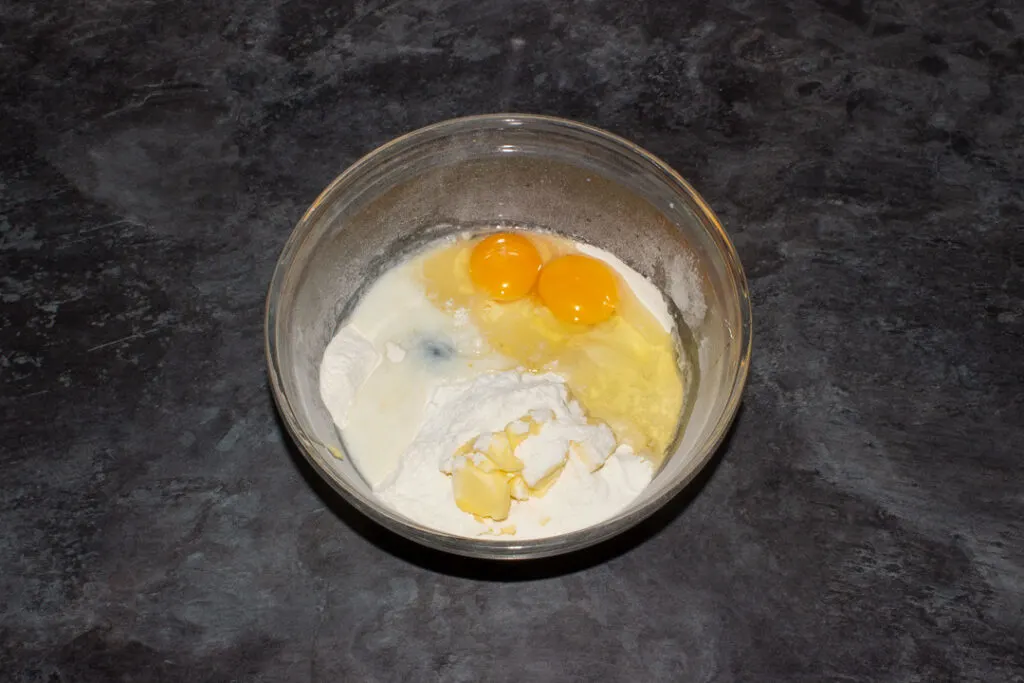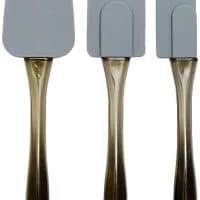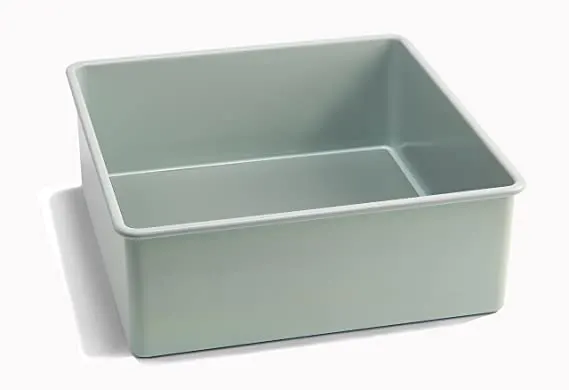This post may contain affiliate links. Where I make a small commission on purchased items, at no extra cost to you. See my disclosure for details.
Looking for a speedy cake recipe? One that looks fabulous but is secretly very easy to make? This Biscoff traybake recipe is exactly what you need! Using the all in one cake method, this showstopping cake is quick to make and absolutely delicious! Keep reading for the full recipe, helpful tips, and more…

Why you’ll love this recipe
It’s no secret that I’ve loved Biscoff for quite a long time. And the are many Biscoff recipes on Kitchen Mason to prove it! But combining Biscoff with my favourite all in one cake method is something that needed to be done!
This cake is so quick and easy to make, it’s often one I whip up when I’m in a hurry, or have last minute plans with friends and family. I’m sure you’ll love it just as much as I do!

What is Biscoff?
Biscoff is a biscuit made my a company called Lotus. It’s commonly served alongside tea and coffee in cafes and coffee shops. Due to the biscuit’s popularity, they have increased the Biscoff biscuit variety available (including chocolate covered and cream filled versions), and added smooth and chunky spreads, ice creams and more to their range of products.

How to make Biscoff traybake
Just like this lemon traybake, making Biscoff traybake cake is super simple. All you do is mix together the cake ingredients, pour the batter into a tin, and bake it. Then allow it to cool, fill poked holes with melted Biscoff, and top with Biscoff icing and crushed Biscoff biscuits.

Ingredients
Confused about what ingredients to buy? Not sure about a substitution? Here’s everything you need to know…
- Butter – I always use good quality unsalted butter in baking. I realise this can be expensive though, so any butter (even if it’s salted) will work just fine.
- Sugar – Caster sugar (superfine in the US) is best in cakes as its fine crystals dissolve quickly into batter. Don’t substitute for granulated sugar, as this has much larger crystals.
- Flour – You need self raising flour in this Biscoff sponge cake. If you only have plain flour, here’s how to make self raising flour.
- Baking Powder – Do NOT substitute this with bicarbonate of soda. They react differently and cannot be interchanged in recipes. Only baking powder will work in this particular recipe.
- Eggs – Large free range eggs are my go to. So long as your eggs aren’t tiny or massive, whatever you have should work absolutely fine.
- Milk – I tend to go with semi-skimmed milk, but any milk will work. Even alternatives such as almond milk or soy milk.
- Vanilla – I’m passionate about good quality vanilla, be it paste or extract. Supermarket version are genuinely AWFUL and a complete waste of money. Use one like Little Pod or Nielsen Massey for a huge boost in flavour!
- Biscoff spread – The original Lotus Biscoff spread can be quite expensive unless it’s on offer, but don’t worry! This is something supermarket’s actually do pretty well! You can use a cheaper alternative here, and the flavour will be very similar.
- Icing sugar – Also known as confectioners sugar – there is no alternative here, but brand really doesn’t matter. So go cheap and save pennies!

Emma’s top tips
Here are tips you’ll find helpful when making a Biscoff traybake.
- For the all in one method to work, all ingredients need to be at the same temperature. So make sure you take your eggs and butter out the fridge an hour or so before starting.
- Forgot to take the chilled ingredients out the fridge? Here’s how to soften butter quickly, and how to bring eggs to room temperature quickly.
- Remember that all ovens vary, so keep a close eye on your cake in the last few minutes of cooking.
- Save a few pennies by using supermarket own brand caramelised biscuits and spread.

Timings
Have limited time? Struggle with recipe timings? Or juggling around other things? Here’s some time managing info to make your life easier.
- Bring your chilled ingredients to room temperature before you start baking. The time it takes will vary depending on how warm your house is, and what time of year it is. (See Recipe Tips for how to do it quickly if you forgot.)
- Making the cake batter will only take 10 minutes.
- Preheating your oven will take 10-20 minutes. You can do this while you’re making your cake batter to save time.
- Baking takes between 20-25 minutes.
- You must allow your cake to fully cool before decorating. This will take between 30-60 mins. I recommend removing the cake from the tin to achieve this in the fastest time.
- Making the Biscoff frosting will take around 10 mins.
- Filling the cake with Biscoff spread will only take 2-3 mins.
- Assembling/decorating will take no more than 5 mins.

If you like this Biscoff traybake recipe…
…you might also like:
Lotus Biscoff Traybake – Step by Step Picture Recipe
(For a printer friendly version, see the recipe card at the end of this post)
Please note, this recipe includes both UK metric and US Cup measurements.
Ingredients
Here is what you will need to serve 16 (or 9 larger servings).
Important! All ingredients must be at room temperature before you begin, for the ‘all in one’ cake method to work.
For the cake
- 135g (1/2 Cup + 1 tbsp) Unsalted Butter, room temperature
- 135g (1/2 Cup + 1 tbsp) Caster Sugar
- 135g (3/4 + 1/8 Cup) Self Raising Flour
- 1 1/4 tsp Baking Powder
- 2 x Eggs, room temperature
- 3 tbsp Milk
- 1 tsp Vanilla
For the frosting
- 100g (1/2 Cup) Unsalted Butter, room temperature
- 240g (2 Cups) Icing Sugar
- 100g (1/2 Cup) Smooth Biscoff Spread
- 1 1/2 tbsp Milk
To fill and decorate
- 80g (1/4 + 1/8 Cup) Smooth Biscoff Spread
- 2-3 Biscoff Biscuits, crushed
Essential equipment
- 20cm (8″) Square Baking Tin
- Large Mixing Bowl
- Electric Hand Whisk
- Spatula
- Cooling Rack
- Wooden Spoon (or similar utensil)
- Small Microwavable Bowl
- Spoon
Cake instructions
First, lightly grease and line the base and sides of the square cake tin, and preheat your oven to 170°C/Fan 160°C/338F.
(As you can see, I’m a little lazy with this. I only ever line 2 sides, and hold them up with pegs. Don’t judge me, it works. I’ve done it for years!)

Next, add all the cake ingredients to a large mixing bowl. (135g | 1/2 Cup + 1 tbsp softened butter, 135g | 1/2 Cup + 1 tbsp sugar, 135g | 3/4 + 1/8 Cup self raising flour, 1 1/4 tsp baking powder, 2 x eggs, 3 tbsp milk, 1 tsp vanilla.)

Then, using an electric hand whisk with the beaters attached, mix until everything is JUST blended together. Don’t over mix or your cake will end up dense.

Next, pour the batter into the prepared cake tin and smooth out with a spatula.

Bake the cake for 20-25 minutes, until a skewer or knife inserted into the middle comes out clean.

When it’s cool enough to handle, carefully remove the cake from the tin, peel off the baking paper, and cool completely on a wire rack.

Frosting instructions
Meanwhile, while the cake is cooling, let’s make the Biscoff frosting.
In a mixing bowl using your electric whisk, beat the butter (100g | 1/2 Cup) until very soft.

Then gradually beat in the icing sugar (240g | 2 Cups). I usually add it in thirds, and start on a slow speed after each addition – working up to a faster speed. (Otherwise you end up in a mushroom cloud of sugar!)
Once all of the sugar has been added, continue whisking until it’s very light and pale in colour.

Finally, add in the Biscoff spread (100g | 1/2 Cup) and milk (1 1/2 tbsp), and continue to whisk until everything is JUST blended together. Don’t be tempted to overdo this final stage.

Filling instructions
Now your cake has cooled, it’s time to fill it with Biscoff!
Take the end of a wooden spoon (or similar) and poke holes into the cake. Be careful not to go all the way through.

Then place the Biscoff spread (80g | 1/4 + 1/8 Cup) into a small microwavable bowl, and heat for 20-30 seconds. Stir well with a spoon, it should be nice and runny.

Next, pour the melted Biscoff over the cake, and push it into the holes using the spoon.

Biscoff traybake decorating instructions
To decorate your traybake, smooth the Biscoff frosting over the top with a spatula. Then sprinkle crushed Biscoff biscuits around the edge.

(And, before you ask, I couldn’t wait to try a piece – hence why there’s a big hole in the corner of the cake haha!)

How to store Biscoff traybake cake
Store your Biscoff traybake cake in a metal container at room temperature. I don’t like using plastic containers to store cake, as sugar sweats in plastic. And this generally makes quick work of ruining your masterpiece!
This is best consumed within 2-3 days.

FAQs
Biscoff biscuits taste of caramelised biscuit. It’s a very distinct and unique flavour, that can’t really be confused with anything else on the market!
There are so many things you can do with Biscoff spread! Obviously you can make this Biscoff tray bake! You can also make showstopping desserts like Biscoff cake, or a Biscoff cheesecake. Or even lovely edible gifts in the form of Biscoff fudge or Biscoff rocky road. The possibilities are almost endless!
Yes, Biscoff spread can be melted. But it will only last for a brief time. Once cooled, the spread will return to it’s original consistency. Which works perfectly in this Biscoff cake traybake recipe!
Loved this Biscoff traybake recipe? Pin it!


Easy Biscoff Traybake Cake Recipe
This Biscoff traybake cake looks and tastes amazing... and is surprisingly quick and easy to make!
Ingredients
For the cake
- 135g (1/2 Cup + 1 tbsp) Unsalted Butter, room temperature
- 135g (1/2 Cup + 1 tbsp) Caster Sugar
- 135g (3/4 + 1/8 Cup) Self Raising Flour
- 1 1/4 tsp Baking Powder
- 2 x Eggs, room temperature
- 3 tbsp Milk
- 1 tsp Vanilla
For the frosting
- 100g (1/2 Cup) Unsalted Butter, room temperature
- 240g (2 Cups) Icing Sugar
- 100g (1/2 Cup) Smooth Biscoff Spread
- 1 1/2 tbsp Milk
To fill and decorate
- 80g (1/4 + 1/8 Cup) Smooth Biscoff Spread
- 2-3 Biscoff Biscuits, crushed
Essential equipment
- 20cm (8") Square Baking Tin
- Large Mixing Bowl
- Electric Hand Whisk
- Spatula
- Cooling Rack
- Wooden Spoon (or similar utensil)
- Small Microwavable Bowl
- Spoon
Instructions
For the cake
- Lightly grease and line the base and sides of the baking tin, and preheat your oven to 170°C/Fan 160°C/338F.

- Add all the cake ingredients to a large mixing bowl and beat together to form a smooth batter with an electric hand whisk. Do not over mix.


- Smooth the batter out into the prepared tin and bake for 20-25 mins, until a skewer or knife inserted into the centre comes out clean.


- When cool enough to handle, remove the cake from the tin and peel away the paper. Place on a wire rack to cool completely.

For the frosting
- Beat the butter in a mixing bowl with the electric whisk until softened.

- Beat in the icing sugar in thirds. Start on a slow speed then gradually get faster to avoid making a mess. Once all added, continue whisking until it becomes very light and pale in colour.

- Add the Biscoff spread and milk. Beat briefly, just until everything is evenly blended. Do not over mix.

To fill the cake
- When the cake has cooled, poke holes into the top with the back of a wooden spoon, about two thirds the depth of the cake. (Be careful not to go all the way through.)

- Heat the Biscoff spread in a small bowl in the microwave for 20-30 seconds until runny. Stir well with a spoon.

- Pour the melted Biscoff over the top of the cake and encourage it to go into all the holes with the spoon.

To decorate
- Smooth the Biscoff frosting over the top of the cake, and scatter crushed Biscoff biscuit crumbs around the edge.

Notes
If you would rather use a more in depth picture recipe, please see the main body of this post. Where you’ll also find lots of extra FAQs and helpful tips, should you need them.
Please note, this recipe includes both UK metric and US Cup measurements.
Storage
Store your Biscoff traybake in a metal container at room temperature, and consume within 2-3 days.
Tips
- For the all in one method to work, all ingredients need to be at the same temperature. So make sure you take your eggs and butter out the fridge an hour or so before starting.
- Forgot to take the chilled ingredients out the fridge? Here’s how to soften butter quickly, and how to bring eggs to room temperature quickly.
- Remember that all ovens vary, so keep a close eye on your cake in the last few minutes of cooking.
- Save a few pennies by using supermarket own brand caramelised biscuits and spread.
Recommended Products
As an Amazon Associate and member of other affiliate programs, I earn from qualifying purchases at no extra cost to you.
Nutrition Information:
Yield: 16 Serving Size: 1Amount Per Serving: Calories: 265Total Fat: 14gSaturated Fat: 8gTrans Fat: 0gUnsaturated Fat: 5gCholesterol: 55mgSodium: 195mgCarbohydrates: 33gFiber: 0gSugar: 24gProtein: 2g
Nutritional information on kitchenmason.com should only be used as a general guideline, I am not a certified nutritionist. Please always check labels for allergens where applicable.
I want to see YOUR baking!
Have you made this gorgeous Biscoff traybake? I’d love to know if you have! Tag me in your pics on Facebook, Twitter and Instagram or email me at emma@kitchenmason.com.
Other tasty Biscoff recipes

Experienced British Online Publisher, recipe writer, and home cook, Emma has a background of over 20 years in British cuisine and cooking. Born and bred in the UK, she excels in classic British dishes, is passionate about air frying, and loves sharing her Gran’s old school recipes. She has been featured in popular publications such as Food Network, Cosmopolitan, and The Huffington Post.
Knowledgeable On: Traditional British Cuisine, Recipe Writing, Air Frying, Home Cooking.
















